When it comes to the battle of the cookware titans, Stainless Steel and Nonstick are heavyweight contenders vying for a place in every kitchen.
Like dueling gladiators, they each bring their strengths and weaknesses to the culinary arena, promising a cooking experience that’s as thrilling as it is flavorful.
Let’s delve into this clash of kitchen champions to uncover the secrets behind their sizzling performances and help you choose the ultimate kitchen ally for your culinary conquests.

Stainless Steel Vs Nonstick
When it comes to cookware, stainless steel offers durability and versatility, while nonstick pans excel at easy food release and low-fat cooking.
Stainless steel and nonstick cookware are two popular options in the kitchen, each with its unique advantages.
Stainless steel pans are known for their durability, heat retention, and ability to create a good sear on food. They are also dishwasher safe and resistant to scratches and stains.
On the other hand, nonstick pans are prized for their effortless food release, requiring less oil or butter for cooking and easy cleanup.
However, they may not be as durable as stainless steel and can wear out over time, especially if not cared for properly. Ultimately, the choice between stainless steel and nonstick cookware depends on individual cooking preferences and needs.
Here’s a comparison table for Stainless Steel Vs Nonstick:
| Feature | Stainless Steel Pan | Nonstick Pan |
|---|---|---|
| Durability | Highly durable and resistant to scratches | Less durable, can wear out over time |
| Cooking Performance | Creates a good sear on food, retains heat well | Effortless food release, requires less oil/butter |
| Maintenance | Dishwasher safe, resistant to stains and scratches | Hand wash recommended, can degrade with scratches |
| Versatility | Oven-safe and suitable for all types of cooking | Limited to medium heat, not suitable for all foods |
| Longevity | Long-lasting if cared for properly | Lifespan can be shorter if not handled carefully |
| Price | Typically more expensive than nonstick pans | Generally more affordable |
What Is Stainless Steel Pan?
A stainless steel pan is a type of cookware made primarily from stainless steel, an alloy composed of iron and a minimum of 10.5% chromium.
This composition gives stainless steel pans their unique properties, including durability, resistance to rust and corrosion, and a sleek, modern appearance.
Stainless steel pans often have an aluminum or copper core to improve heat distribution, making them ideal for tasks like searing, sautéing, and frying. They are versatile, compatible with various heat sources including induction cooktops, and are generally dishwasher safe.
Stainless steel pans are favored by many chefs and home cooks for their longevity, ease of maintenance, and ability to handle high temperatures without warping or reacting with acidic foods.
What Is A Nonstick Pan?
A nonstick pan is a type of cookware designed with a special coating that prevents food from sticking to its surface during cooking. The coating is typically made from materials like polytetrafluoroethylene (PTFE), also known as Teflon, or ceramic.
Nonstick pans are widely used for cooking delicate foods like eggs, pancakes, and fish, as they require minimal oil or butter and allow for easy food release.
They are easy to clean and maintain, often requiring only a gentle wash with warm, soapy water. However, it’s important to note that nonstick coatings can wear off over time, especially if scratched or exposed to high heat.
Some modern nonstick pans are made with more durable coatings that are PFOA-free (perfluorooctanoic acid) for added safety and longevity.
Strengths And Weaknesses Of Stainless Steel Pans
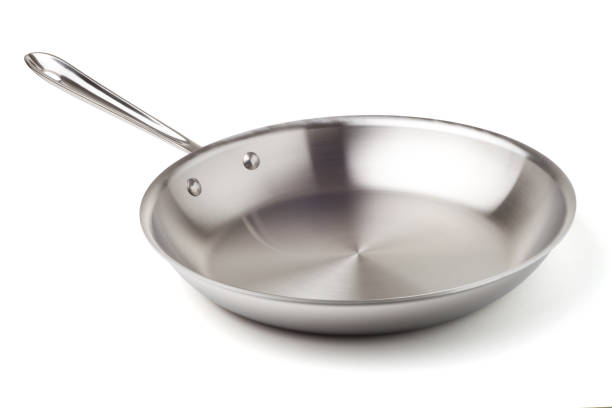
Here are the strengths and weaknesses of stainless steel pans:
Strengths
- Durability: Stainless steel pans are highly durable and resistant to scratches, dents, and corrosion.
- Heat Retention: They have excellent heat retention properties, allowing for even cooking and good searing.
- Versatility: Stainless steel pans are versatile and can be used for a wide range of cooking methods, including searing, sautéing, frying, and baking.
- Compatibility: They are compatible with all types of cooktops, including induction, gas, electric, and halogen.
- Easy Maintenance: Stainless steel pans are generally dishwasher safe and easy to clean with regular washing.
Weaknesses
- Heat Conductivity: Stainless steel alone is not the best conductor of heat, so some pans may have hot spots if not properly designed with an aluminum or copper core.
- Stickiness: Certain foods, like eggs and delicate fish, can stick to stainless steel pans if not properly seasoned or used with sufficient oil or butter.
- Price: Compared to nonstick pans, stainless steel pans can be more expensive, especially high-quality ones with multiple layers or enhanced features.
- Maintenance: While they are generally easy to clean, stainless steel pans can develop water spots or stains if not dried properly after washing.
- Weight: Stainless steel pans can be heavier than other types of cookware, which may be a consideration for some users, especially those with mobility issues.
Strengths And Weaknesses Of Nonstick Pans
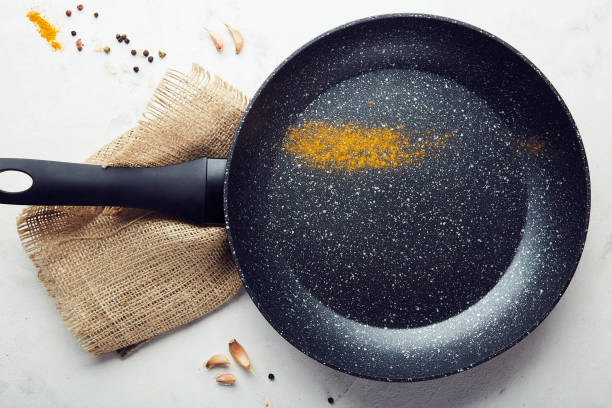
Here are the strengths and weaknesses of nonstick pans:
Strengths:
- Effortless Food Release: Nonstick pans allow for easy release of food without sticking, making them ideal for cooking delicate items like eggs, pancakes, and fish.
- Low Oil Usage: They require minimal oil or butter for cooking, making meals healthier and reducing calories.
- Easy Cleanup: Nonstick pans are easy to clean and typically only require a gentle wash with soap and water.
- Versatility: They are suitable for a wide range of cooking techniques, from frying and sautéing to baking and reheating.
- Affordability: Nonstick pans are generally more affordable compared to other types of cookware, making them accessible to a wide range of consumers.
Weaknesses:
- Durability: The nonstick coating can wear off over time, especially if scratched or exposed to high heat, reducing the pan’s effectiveness.
- Limited Cooking Methods: Nonstick pans are not suitable for high-heat cooking or use in the oven at very high temperatures, which can damage the coating.
- Compatibility: Some nonstick coatings may not be compatible with metal utensils, requiring the use of softer utensils to avoid scratching.
- Replacement Costs: Due to the limited lifespan of the nonstick coating, users may need to replace nonstick pans more frequently than other types of cookware.
- Health Concerns: Traditional nonstick coatings contain PTFE (Teflon) and PFOA, which can release harmful fumes if overheated. However, many modern nonstick pans are PFOA-free for improved safety.
Similarities Between Stainless Steel Pan And Non-Stick Pan
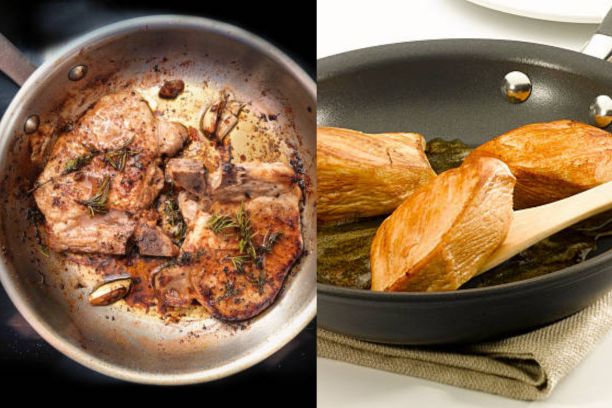
Stainless steel pans and nonstick pans have several similarities despite their differences:
Safe
To ensure a safe cooking experience, it’s important to follow certain guidelines regardless of the type of cookware you use.
Whether using stainless steel pans, nonstick pans, or any other cookware, always start by checking the manufacturer’s instructions for proper usage and care.
This includes recommended heat levels, compatible utensils, and cleaning methods. Additionally, when using stainless steel pans, avoid overheating them as this can lead to discoloration or warping.
For nonstick pans, use low to medium heat settings to prevent the nonstick coating from deteriorating and releasing harmful fumes. Always use oven mitts or handles to handle hot pans, and never leave them unattended on a hot stove.
Regularly inspect your cookware for signs of wear or damage and replace as needed to maintain a safe cooking environment.
Compatible With Different Cooktops
Cookware compatibility with various cooktops is an essential consideration for efficient and safe cooking. Stainless steel pans and nonstick pans both offer versatility in this aspect.
Stainless steel pans are generally compatible with all types of cooktops, including gas, electric, ceramic, induction, and halogen. This makes them suitable for use in a wide range of kitchens and cooking environments.
On the other hand, nonstick pans are also compatible with most cooktops, with the exception of induction cooktops unless specifically designed with an induction-compatible base.
This compatibility allows users to seamlessly transition between different cooking methods and appliances, ensuring convenience and flexibility in their culinary endeavors.
Heat Transfer
Both stainless steel pans and nonstick pans exhibit distinct characteristics in terms of heat transfer during cooking. Stainless steel pans are known for their excellent heat retention and distribution properties, which allow for even cooking and a good sear on food.
They can withstand high heat levels, making them suitable for tasks like searing meats or achieving crispy textures. However, stainless steel alone is not the best conductor of heat, so some pans may have hot spots if not properly designed with an aluminum or copper core.
On the other hand, nonstick pans are designed with materials that offer quick and even heat distribution, ensuring that food cooks evenly without hot spots.
The nonstick coating also helps in regulating heat and preventing food from burning or sticking. However, nonstick pans may not be suitable for high-heat cooking methods, as excessive heat can damage the nonstick coating over time.
Concisely, while both types of pans have their strengths in heat transfer, stainless steel pans excel in high-heat cooking and searing, while nonstick pans offer even heat distribution and prevention of food sticking or burning at moderate heat levels.
Durability
When it comes to durability, stainless steel pans and nonstick pans have distinct characteristics and considerations. Stainless steel pans are known for their exceptional durability and resistance to scratches, dents, and corrosion.
They are less prone to damage from utensils and cleaning tools, making them suitable for long-term use. Moreover, stainless steel pans can withstand high temperatures without warping or deteriorating, adding to their longevity.
Nonstick pans, on the other hand, have a different type of durability. The durability of a nonstick pan depends largely on the quality of the nonstick coating and how it is cared for.
High-quality nonstick coatings can withstand moderate use and gentle cleaning without deteriorating quickly. However, they are more susceptible to scratches from metal utensils and abrasive cleaning tools, which can reduce their lifespan.
Exposure to high heat can also degrade the nonstick coating over time, affecting its performance and durability.
Concisely, while stainless steel pans are generally more durable due to their sturdy construction and resistance to damage, nonstick pans can also be durable with proper care and maintenance.
Users should handle nonstick pans gently, avoid using metal utensils, and follow manufacturer’s instructions for cleaning and heat usage to prolong their durability.
Appearance
The appearance of stainless steel pans and nonstick pans differs significantly, catering to different aesthetic preferences and kitchen styles.
Stainless steel pans are characterized by their sleek, shiny, and professional appearance, adding a modern and sophisticated touch to any kitchen.
The reflective surface of stainless steel pans can also make them visually appealing and easy to clean, as stains and residue are more visible, prompting regular maintenance for a pristine look.
On the other hand, nonstick pans often feature a smooth, matte finish due to the nonstick coating applied to the cooking surface. This coating can come in various colors, offering a range of options to match or complement kitchen decor.
Nonstick pans are often preferred for their minimalist and clean appearance, as well as their ability to showcase vibrant colors or designs in the coating.
Ultimately, the choice between stainless steel pans and nonstick pans in terms of appearance depends on personal style preferences and the desired aesthetic impact in the kitchen.
Both types of pans can contribute to a well-coordinated and visually pleasing culinary space, whether opting for the modern elegance of stainless steel or the colorful simplicity of nonstick coatings.
Differences Between Non-Stick Pan And Stainless Steel Pan
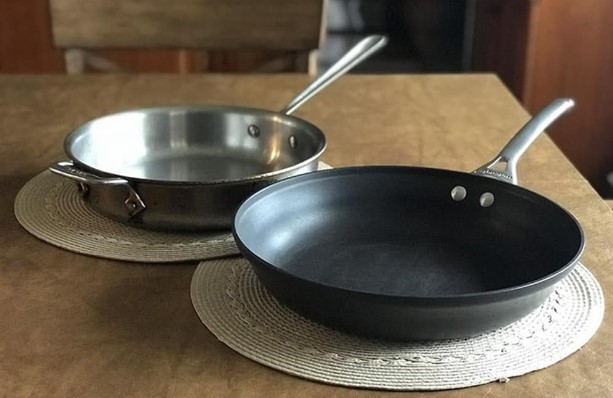
Here are the differences between nonstick pans and stainless steel pans based on the specified criteria:
Stickiness
- Nonstick Pan: Nonstick pans are designed to prevent food from sticking to the cooking surface, making them ideal for cooking delicate items like eggs, pancakes, and fish without the need for excess oil or butter.
- Stainless Steel Pan: Stainless steel pans may require more oil or butter to prevent sticking, especially when cooking foods that tend to adhere to surfaces, such as eggs or fish. Proper seasoning and preheating can help minimize sticking.
Preheating
- Nonstick Pan: Nonstick pans typically require less preheating time due to their quick and even heat distribution properties, which helps in preventing food from sticking and ensures even cooking.
- Stainless Steel Pan: Stainless steel pans may require a longer preheating time to evenly distribute heat throughout the cooking surface, especially for tasks like searing meats or achieving a crispy texture.
Durability
- Nonstick Pan: The durability of a nonstick pan depends on the quality of the nonstick coating and how it is cared for. High-quality nonstick coatings can be durable with proper maintenance, but they may degrade over time, especially with exposure to high heat or abrasive cleaning methods.
- Stainless Steel Pan: Stainless steel pans are known for their durability and resistance to scratches, dents, and corrosion. They can withstand high temperatures and are less prone to damage from utensils and cleaning tools, making them suitable for long-term use.
Dishwasher-Safe
- Nonstick Pan: Many nonstick pans are dishwasher safe, but repeated dishwasher use may reduce the lifespan of the nonstick coating. Hand washing with a gentle detergent is recommended to prolong the nonstick surface.
- Stainless Steel Pan: Stainless steel pans are generally dishwasher safe and can withstand frequent cleaning cycles without affecting their durability or performance.
High Temperature
- Nonstick Pan: Nonstick pans are not suitable for high-temperature cooking, as excessive heat can damage the nonstick coating, leading to potential health concerns and reduced durability.
- Stainless Steel Pan: Stainless steel pans are suitable for high-temperature cooking methods, such as searing and broiling, as they can withstand heat without warping or deteriorating.
However, it’s essential to avoid overheating empty stainless steel pans, as this can cause discoloration or damage.
What To Consider When Choosing Between Nonstick And Stainless Steel Pans
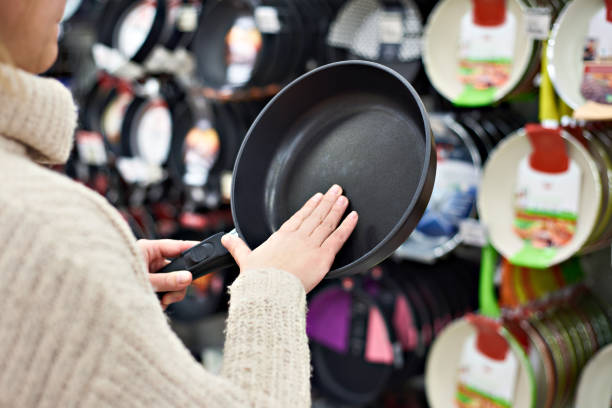
When choosing between nonstick and stainless steel pans, consider the following factors to make an informed decision:
Cooking Preferences
Think about the types of foods you frequently cook and your preferred cooking methods. Nonstick pans are excellent for delicate items like eggs, pancakes, and fish, while stainless steel pans are more versatile for a wide range of cooking techniques, including searing, sautéing, and frying.
Stickiness
Consider how much you mind food sticking to the pan and whether you’re willing to use more oil or butter for cooking. Nonstick pans are designed to minimize sticking, while stainless steel pans may require proper seasoning and technique to prevent sticking.
Heat Tolerance
Determine the cooking temperatures you typically use. Stainless steel pans can withstand high heat levels, making them suitable for tasks like searing and browning, while nonstick pans are not recommended for high-temperature cooking as it can damage the nonstick coating.
Durability
Think about the longevity you expect from your pans. Stainless steel pans are known for their durability and resistance to scratches, dents, and corrosion, while nonstick pans may require more careful handling and maintenance to preserve the nonstick coating.
Ease of Cleaning
Consider your preferred cleaning method. Nonstick pans are often easier to clean due to their nonstick surface, but they may require hand washing and gentle care to avoid damaging the coating. Stainless steel pans are generally dishwasher safe and more forgiving in terms of cleaning.
Budget
Determine your budget and how much you’re willing to invest in cookware. Nonstick pans are generally more affordable upfront, but they may need to be replaced more frequently due to wear and tear of the nonstick coating. Stainless steel pans can be more expensive initially but offer long-term durability.
Cooktop Compatibility
Check the compatibility of the pans with your cooktop. Stainless steel pans are suitable for all cooktops, including induction, while nonstick pans may require specific types of cooktops for optimal performance.
Frequently Asked Questions (FAQs) – Stainless Steel Vs Nonstick
Q: What are the advantages of stainless steel cookware over nonstick?
A: Stainless steel cookware offers durability and versatility, allowing for high-heat cooking, excellent searing, and long-lasting performance.
Q: How does nonstick cookware stand out compared to stainless steel?
A: Nonstick cookware excels in easy cleanup, requires less oil for cooking, and is ideal for delicate foods like eggs and pancakes.
Q: Is stainless steel cookware suitable for all cooking methods?
A: Yes, stainless steel is compatible with various cooking methods, including stovetop, oven, and even induction cooking, making it a versatile choice for any kitchen.
Q: What about the maintenance of stainless steel versus nonstick?
A: Stainless steel is easy to clean and is dishwasher safe, while nonstick requires gentle hand washing to preserve its coating for long-term use.
Q: Which type of cookware is more environmentally friendly?
A: Stainless steel cookware is eco-friendly as it can last for generations with proper care, reducing the need for frequent replacements compared to nonstick pans.
Q: Can stainless steel cookware withstand high temperatures?
A: Yes, stainless steel is designed to withstand high heat, making it perfect for tasks like searing and browning meats to perfection.
Q: Are there any health benefits associated with using stainless steel cookware?
A: Stainless steel is non-reactive and does not leach chemicals into food, providing a safe and healthy cooking surface.
Q: What makes nonstick cookware a popular choice for everyday cooking?
A: Nonstick cookware’s easy release properties make cooking and cleanup a breeze, saving time and effort in the kitchen.
Q: Can stainless steel cookware be used with metal utensils?
A: Yes, stainless steel is highly durable and can withstand the use of metal utensils without scratching or damaging the cooking surface.
Q: Is there a difference in cooking performance between stainless steel and nonstick?
A: Both types of cookware excel in different ways; stainless steel offers superior browning and versatility, while nonstick is best for low-fat cooking and easy cleaning.
Conclusion
In conclusion, the choice between stainless steel and nonstick cookware ultimately depends on individual preferences, cooking habits, and priorities.
Stainless steel offers durability, versatility, and the ability to achieve a perfect sear, making it ideal for a wide range of cooking techniques.
On the other hand, nonstick cookware excels in easy cleanup, especially for delicate foods like eggs and fish.
It’s crucial to consider factors such as cooking style, maintenance preferences, and long-term durability when deciding between stainless steel and nonstick cookware.
Ultimately, both types have their unique benefits and can be valuable additions to a well-equipped kitchen.